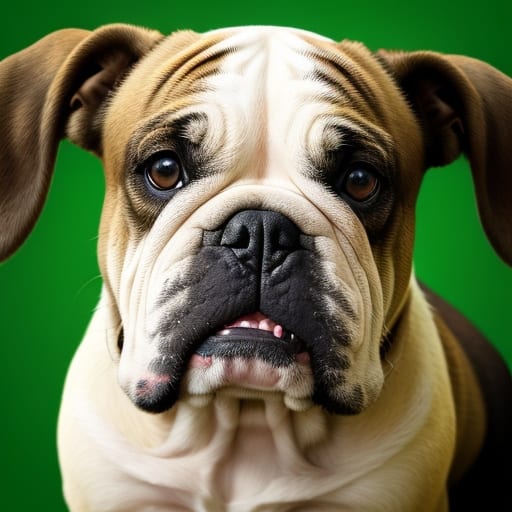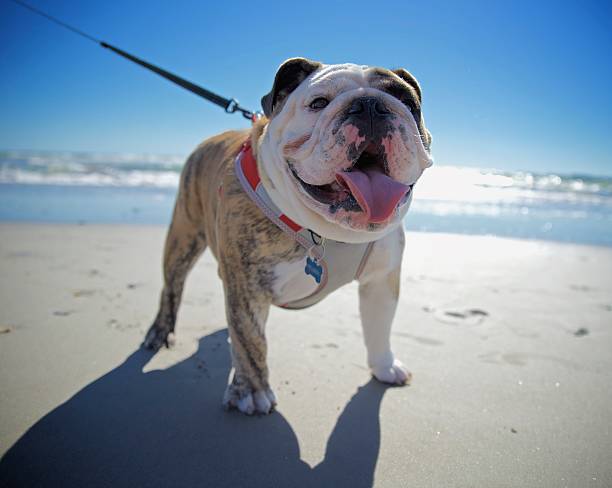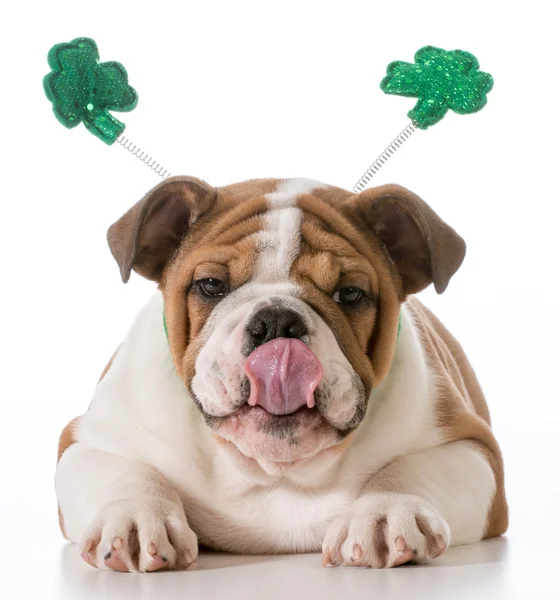The Irish Bulldog, a delightful symbol of charm, loyalty, and friendly nature, captures the hearts of dog lovers and families who appreciate its amiable disposition and distinctive appearance. With its warm personality, unmistakable looks, and unwavering devotion, this breed has firmly established itself as a beloved family member and a symbol of Irish canine heritage.

| Category (Explanation) | Breed Information |
|---|---|
| Year of Breed Conception | Ancient |
| Country of Origin | Ireland |
| Weight (Male) | 55-80 lbs (25-36 kg) |
| Weight (Female) | 45-70 lbs (20-32 kg) |
| Coat Type | Short, dense |
| Color Variations | White, brindle, or red with black mask |
| Shedding Level | Low to moderate |
| Height (cm & in) | 51-61 cm (20-24 inches) |
| Breed Size | Medium to large |
| Trainability | Moderate |
| Mental Needs | Moderate |
| Intelligence Level | Moderate |
| Energy Level | Moderate to high |
| Agility | Moderate |
| Loyalty | High |
| Playfulness | Moderate to high |
| Exercise Needs | Regular exercise and play |
| Guarding Proficiency | Moderate |
| Sociability with Children | High |
| Barking Level | Low to moderate |
| Digging Tendency | Low to moderate |
| Destructive Behavior | Low |
| Drooling Level | Moderate |
| Obedience Level | Moderate |
| Apartment Friendly | Yes, with proper exercise and space |
| Inherent Prey Drive | Moderate |
| Physical Risk to Others | Low to moderate |
| Travel Fatality Risk | Low |
| Allergen Potential | Low (considered hypoallergenic) |
| Health Concerns | Hip dysplasia, respiratory issues |
| Average Life Expectancy | 10-14 years |










































































Woof Mastery is reader supported and our articles may contain affiliate links.
Instead of running third party ads that we have no control of we only use links from high-quality companies we are directly partnered with. Making use of these links come at no cost to you our reader, and in many cases have the extra benefit of discounted rates or sign up bonuses.
If you’re interested you can read more about our affiliate policy here.
We appreciate your support and always insure that the products and services we recommend are high-quality, helpful and relevant to the subject at hand!
The Irish Bulldog’s history is deeply tied to the rural landscapes of Ireland. Bred as farm dogs in the 19th century, they were cherished for their strength and versatility.
Irish Bulldogs played vital roles in herding cattle, guarding livestock, and assisting farmers in their daily tasks. Their journey from hardworking farm dogs to beloved family companions showcases their adaptability and dedication.
Today, Irish Bulldogs stand as a testament to Ireland’s agricultural heritage, embodying the tenacity and spirit of the Irish countryside. They continue to be loyal family protectors and cherished companions.

What sets the Irish Bulldog apart is its history as a symbol of Ireland’s tenacity and spirit. These dogs have a reputation for determination and courage, traits closely associated with the Irish people. Irish Bulldogs may have a strong-willed nature, but they also possess a deep loyalty and affection for their families.
They form strong bonds and provide unwavering companionship. Their unique connection to Irish history, combined with their loving disposition, makes Irish Bulldogs truly special and cherished companions, embodying the resilience and warmth of the Irish spirit.
The traditional role of the Irish Bulldog included various tasks such as hunting and herding. Their agility and strength made them well-suited for these activities. Today, they continue to excel as affectionate family pets, offering both companionship and athleticism to their owners.
Irish Bulldogs are renowned for their spirited and affectionate personalities. They are known to be highly playful and energetic, often displaying a keen love for human interaction.
Their intelligence and their eagerness to please are evident, making them trainable and adaptable companions for those willing to engage their active minds. Irish Bulldogs may be cautious when meeting strangers but form strong bonds with their owners. They exemplify a mix of charm, courage, and a zest for life, adding a vibrant and loving presence to any home.
Irish Bulldogs are recognized for their spirited and affectionate temperament. They are highly playful and energetic, often displaying a keen love for human interaction.
Their intelligence and their eagerness to please are evident, making them trainable and adaptable companions for those willing to engage their active minds. Irish Bulldogs may be cautious when meeting strangers but form strong bonds with their owners.
They exemplify a mix of charm, courage, and a zest for life, adding a vibrant and loving presence to any home. Early training and socialization are crucial for nurturing a well-adjusted temperament in this breed.
Irish Bulldogs are medium-sized dogs known for their strong, muscular build. Their square-shaped head features a well-defined jawline, giving them a distinctive and confident appearance.
Their medium-sized, round eyes typically come in various shades of brown, exuding warmth and friendliness. Ears are medium-sized and fold forward, adding to their endearing expression.
These dogs have a short, dense coat that provides protection and comes in various colors, often with white markings. Their skin is thick and slightly loose, especially around the neck, creating a charming and lovable wrinkled appearance.
The neck is powerful, leading to a broad chest and sturdy, straight legs, ensuring their strength and stability. The tail is typically straight and tapered, contributing to their well-balanced and harmonious physique.
In terms of size, males stand around 20-24 inches (51-61 cm) at the shoulder, and females are slightly smaller. Weight ranges from 55 to 85 pounds (25-39 kg) for males and slightly less for females. Irish Bulldogs have an appearance that reflects their strength, confidence, and friendly disposition, making them loyal and amiable companions.
Overall, Irish Bulldogs possess a well-proportioned, muscular body that mirrors their history as hardworking and adaptable dogs. Their appearance exudes confidence, athleticism, and a touch of charm. Amongst this breed, males typically have a more robust and imposing presence compared to females, highlighting their resilience and versatility.
Irish Bulldogs boast a variety of appealing coat colors, enhancing their charming character. The primary color varieties for Irish Bulldogs include:
Irish Bulldogs often have a low shedding level. They are not known to be heavy shedders, and their shedding is generally minimal year-round. Occasional grooming and brushing with a soft bristle brush can help manage shedding and maintain their coat’s health.
Factors that affect shedding in Irish Bulldogs can be influenced by genetics, overall health, and diet. Regular exercise and a well-balanced diet contribute to coat health and may reduce shedding. Providing a stress-free environment can help minimize stress-related shedding.
Irish Bulldogs, known for their affectionate nature, have a coat that’s smooth to touch but requires consistent care.
Brushing: A weekly brushing regime, using a firm bristle brush, ensures the removal of loose hairs and stimulates skin health.
Bathing: Depending on their outdoor activities, a 5-6 week bathing schedule using a moisturizing dog shampoo can be beneficial.
Ears: Their floppy ears can be a potential hotspot for infections if moisture is trapped. Bi-weekly cleaning, using a vet-approved solution, is crucial.
Nails: Regular trimming, preferably every 2-3 weeks, combined with routine checks post outdoor escapades, can ensure optimal paw health.
Teeth: Their broad muzzle makes them susceptible to dental ailments. Thus, daily brushing, combined with dental treats, is essential.
Wrinkle Care: Any creases, especially around the muzzle, need consistent care. Regular cleaning, followed by thorough drying, prevents bacterial growth.
Eye Care: Their expressive eyes should be inspected daily for any signs of redness or irritation.
Irish Bulldogs, also known as Glen of Imaal Terriers, have a moderate activity level. They are known for their tenacity and working abilities. Here are some key points to consider about their activity level:
The Irish Bulldog showcases a moderate level of intelligence, characterized by adaptability, problem-solving abilities, and a strong desire to please their owners. Here are key points about their intelligence:
While not the smartest, Irish Bulldogs excel as easygoing and devoted family companions. Training, socialization, and mental stimulation are essential to help them reach their full potential.
Irish Bulldogs need mind workouts. Offer them challenging toys, obedience courses, or partnership plays.
Social Interaction: Irish Bulldogs adore human bond. Lack of interaction might lead to emotional stress.
Exercise: Irish Bulldogs require routine exercise. It ensures their mental and physical wellbeing.
Training and Obedience: Training with positive rewards works best with Irish Bulldogs. Consistency is the key.
Routine and Structure: Irish Bulldogs feel safe in a structured environment. Routine daily activities bring them peace. A
ffection and Attention: Irish Bulldogs, with their loving demeanor, deserve ample attention. Ensure to have bonding moments with them.
Socialization: Early social experiences are crucial for Irish Bulldogs. Ensure they interact with various environments and beings.
Safe Environment: Irish Bulldogs value a secure environment. Dedicate a comforting zone in your home for their relaxation.
Consistency: Being consistent in routines and commands assures Irish Bulldogs, offering them a sense of stability.
Enter The Woof Mastery

Before welcoming an Irish Bulldog into your home, it’s important to understand their unique needs. Irish Bulldogs are known for their friendly and affectionate personalities. They require regular exercise and mental stimulation to thrive. Training and socialization are vital to ensure they are well-behaved.
Be prepared for potential health concerns, such as respiratory issues due to their flat faces. Responsible ownership involves being prepared for grooming and providing a loving and secure environment for these devoted and spirited companions.
Irish Bulldogs, with their amiable nature and affectionate temperament, generally pose a lower potential physical danger to others compared to some more aggressive breeds. However, it’s crucial to remember that a dog’s behavior depends on factors such as individual temperament, upbringing, training, and owner responsibility. Here are some considerations regarding their potential physical danger:
Irish Bulldogs are renowned for their spirited and affectionate personalities. They are known to be highly playful and energetic, often displaying a keen love for human interaction.
Their intelligence and their eagerness to please are evident, making them trainable and adaptable companions for those willing to engage their active minds. Irish Bulldogs may be cautious when meeting strangers but form strong bonds with their owners. They exemplify a mix of charm, courage, and a zest for life, adding a vibrant and loving presence to any home.
Irish Bulldogs, lesser-known but with unique attributes, have a set of characteristics influencing their water affinity. Here are some factors to consider:
Though some Irish Bulldogs might manage to swim or enjoy splashing in shallow waters, always prioritize their safety and comfort during any aquatic engagement.
Irish Bulldogs, renowned for their friendly and affectionate nature, may express themselves through various vocalizations. Here are some common noises they may make:
Owners of Irish Bulldogs should pay attention to these vocalizations and understand the context in which they occur. While many of these noises are endearing and normal, some may indicate a need for interaction or companionship. Positive reinforcement training can help shape and manage their vocal behaviors.
Irish Bulldogs thrive in homes where they receive love, structure, and opportunities for socialization. Here are some ideal living conditions for Irish Bulldogs:
Challenges:
When it comes to travel fatality risk for Irish Bulldogs, consider the following potential constraints:
By addressing these potential constraints and taking necessary precautions, you can help ensure the safe travel of your Irish Bulldog and minimize travel-related risks.
Irish Bulldogs may be prone to specific health concerns. While not all individuals will experience these issues, it’s essential for Irish Bulldog owners to be aware of potential health problems and work with veterinarians to maintain their pets’ well-being. Common health concerns in Irish Bulldogs include:
Regular veterinary check-ups, a balanced diet, proper exercise, and responsible breeding practices can help mitigate some of these health concerns. It’s crucial for Irish Bulldog owners to work closely with their veterinarians to monitor their pets’ health and address any issues promptly.
Proper nutrition is crucial for the health and well-being of Irish Bulldogs. Here are some nutritional habits and best practices to consider for this breed:
Breed-Specific Laws (BSL): Irish Bulldogs might occasionally be affected by breed-specific laws (BSL) in certain jurisdictions. These regulations are commonly decided at the local or city level.
Types of Restrictions: For Irish Bulldogs, BSL might encompass requirements like mandatory spaying/neutering, specific licensing, insurance liabilities, public muzzling, and in some circumstances, bans on ownership. The extent of these restrictions is often localized.
Rationale for BSL: BSL often originates from public safety concerns related to certain dog breeds. The Irish Bulldog, being a lesser-known variety, might still face such laws due to their bulldog lineage.
Controversy: BSL remains under scrutiny, with critics pointing out its potential breed bias instead of focusing on individual dog actions and the importance of responsible ownership.
Local Regulations: Before getting an Irish Bulldog, one should be aware of any breed-specific regulations in their area by engaging with local animal control or relevant bodies.
Woof Mastery is reader supported and our articles may contain affiliate links.
Instead of running third party ads that we have no control of we only use links from high-quality companies we are directly partnered with. Making use of these links come at no cost to you our reader, and in many cases have the extra benefit of discounted rates or sign up bonuses.
If you’re interested you can read more about our affiliate policy here.
We appreciate your support and always insure that the products and services we recommend are high-quality, helpful and relevant to the subject at hand!
Myth 1: Irish Bulldogs are Aggressive by Nature
Myth 2: They are High-Energy Dogs
Myth 3: They Can’t Tolerate Cold Weather
Myth 4: They are Not Good with Children
Myth 5: They Shed Excessively
Myth 6: They Don’t Require Training
Myth 7: They are Always Good with Other Dogs
Myth 8: They Are All the Same Size
Myth 9: They are Unhealthy Dogs
Myth 10: They are Always Clingy
The Irish Bulldog holds cultural significance in various contexts:
While there may not be as many famous Irish Bulldog owners as there are for other dog breeds, here are a few notable individuals who have been associated with Irish Bulldogs:
Irish Bulldogs, like many other dog breeds, have faced several threats and challenges over the years. Some of the significant threats and issues that have affected the breed include:
The Irish Bulldog is believed to have been developed from a combination of various breeds, with the primary ancestors being the old Irish breeds and Bulldogs. The breed’s development took place in Ireland, with influences from local strains and breed types. The specific breeds and strains that contributed to the Irish Bulldog’s development include:
Irish Bulldogs are a unique blend of strength and loyalty, making them exceptional family companions. With their muscular build and loving disposition, they effortlessly integrate into our lives, becoming cherished members of our households.
These dogs excel as watchdogs, displaying protective instincts that solidify their role as guardians of our homes. Irish Bulldogs are known for their adaptability, thriving in various living conditions, and requiring only minimal grooming. Their athletic prowess and playful spirit cater to active individuals and families, making them excellent playmates. Their intelligence shines in various activities and training.
Beyond their physical attributes, Irish Bulldogs bring a unique charm to every household, filling the air with their presence. Their versatility is a testament to their adaptability, transitioning effortlessly from beloved family pets to diligent working dogs.
Most importantly, Irish Bulldogs offer profound and unconditional love, forging an unbreakable bond that enriches our lives. If you’re seeking a loyal and affectionate companion, embrace the love and devotion of an Irish Bulldog.